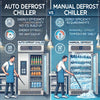
Understanding Auto Defrost vs. Manual Defrost Chillers in Singapore
2 min reading time

2 min reading time

When choosing a chiller in Singapore, one key consideration is whether it comes with an auto defrost feature or requires manual defrosting. The difference affects cooling efficiency, maintenance needs, and energy usage.
Auto defrost chillers automatically remove frost buildup using a heating element or a timed cycle. This ensures consistent cooling performance, preventing ice from forming on the evaporator coils. Since frost buildup can reduce efficiency, auto defrost helps maintain stable temperatures without the need for manual intervention. It also reduces maintenance efforts, making it ideal for businesses that need reliable and hassle-free operation. However, auto defrost systems may cause slight temperature fluctuations during the defrost cycle and can consume slightly more energy.
Chillers without auto defrost require manual defrosting, meaning users must switch off the unit periodically to allow ice to melt. While these chillers generally consume less energy and maintain a more stable temperature for sensitive products (e.g., wines or medical supplies), frost buildup can reduce cooling efficiency over time. Regular maintenance is required to prevent thick ice layers from affecting performance.
| Factor | Manual Defrost Chiller | Auto Defrost Chiller |
|---|---|---|
| Temperature Stability | More stable, ideal for sensitive products like wines or pharmaceuticals. | Slight fluctuations due to defrost cycles, but maintains overall cooling efficiency. |
| Maintenance | Requires periodic manual defrosting to prevent ice buildup. | Minimal maintenance as the system automatically removes frost. |
| Energy Efficiency | Generally lower energy consumption but can become inefficient if frost accumulates. | May use more energy due to heating cycles, but operates more efficiently in high-traffic areas. |
| Best for | Wine storage, pharmaceuticals, frozen food storage with limited access. | Commercial kitchens, convenience stores, restaurants, and high-traffic retail spaces. |
| Convenience | Requires regular monitoring and defrosting. | Hands-free operation, saving time and effort. |
| Initial Cost | Usually lower upfront cost. | Slightly higher cost due to built-in defrosting technology. |